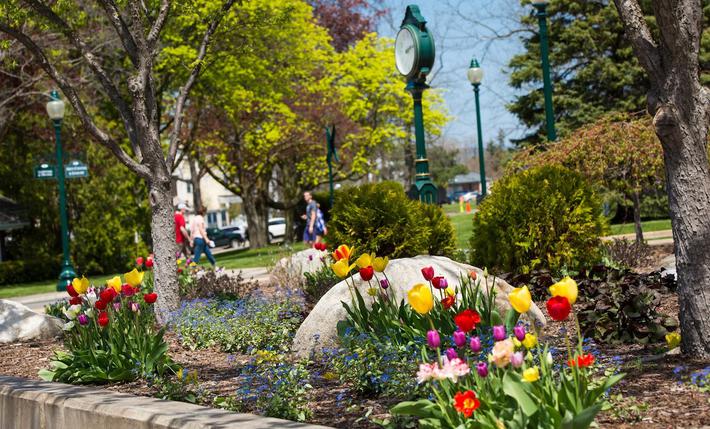
More People, More Visits, More Dialogue
Organizations that work with people experiencing homeless continue to see an uptick in the demand for their services
By Art Bukowski | Jan. 6, 2024
Resources designed to assist people experiencing homelessness in the region are all under strain in the early days of 2024.
Unhoused people in the Grand Traverse region are assisted by a variety of organizations that meet basic needs, from temporary shelter to assistance with food and hygiene. All these organizations are reporting an exponential increase in the use of their services.
“The number of guests we’re seeing is at a record right now—it’s staggering,” says Brad Gerlach, facility manager and volunteer coordinator at Safe Harbor. “We’re at capacity every night, and we’ve had to turn people away.”
Safe Harbor, which began as a collection of churches opening their doors overnight for people experiencing homelessness, now has a permanent 84-bed shelter in Traverse City. Over at the Jubilee House, another facility dedicated to the cause, unhoused people can receive mail, shower, and tend to other basic needs. It’s the same story there, Rev. Derek Quinn tells us.
“November, which is the last month we have statistics for, saw the greatest number of visits to Jubilee House that we’ve ever recorded,” says Quinn, who runs the house as a program of Grace Episcopal Church. “We’ve definitely gotten to the point where we’re seeing a trend line with a true upward trajectory.”
More, but Different
Though advocates say a fully accurate census is sometimes hard to pin down for a variety of reasons, the five-county Grand Traverse region has had a relatively stable population that hovers around 200-250 people experiencing homelessness for several years. It’s up around 275 now, marking a relatively minor increase. The bigger issue may be the way people are interacting with services.
“I think the difference is they’re coming in a more concentrated way. Instead of people just coming and stopping by at Jubilee House, maybe being here for an hour and doing a load of laundry and grabbing a shower and then moving on, we’re seeing more people who want to come and stay for the whole day or for large chunks of time,” Quinn says. “When that happens and more people come in and not as many people are leaving, we end up with a lot more people in the house.”
Ryan Hannon is the community engagement officer at Goodwill Northern Michigan after serving for more than a decade as the organization’s street outreach coordinator. He’s interacted with thousands of people living without permanent homes over the years, and another big difference he’s seeing these days is the physical attributes of the people he’s helping.
“One of the biggest trends I think is we’re working with more physically frail people. There’s a big shortage of adult foster care housing around the state and especially around here,” he says. “So we’re seeing more intense needs for these people, and people who are aging as well.”
Advocates say more people are also ending up in Traverse City from around the region as other municipalities crack down on homelessness. Some areas will arrest unhoused people for trespassing or other concerns.
“Some of the townships have taken steps toward criminalization of homelessness,” says Ashley Halladay-Schmandt, director of the Northwest Michigan Coalition to End Homelessness. “And if we don’t have people feeling like they can safely camp in certain regions, they’re all going to the city.”
The Housing Issue
The Coalition, a group of many organizations dedicated to ending homelessness in the region, has an ambitious goal of ending chronic homelessness—defined as people who have been homeless for a year or longer and are disabled in some way—by 2028. The number of people in this category currently sits around 70. There will only be one way to fix that, Halladay-Schmandt says.
“Data really speaks to the fact that communities that have severe shortages in housing have people staying homeless for longer periods of time, and the biggest reason we have 70 people experiencing chronic homelessness is because we don’t have enough housing,” she says. “We’re always going to have some people who are homeless, but when we don’t have enough outflow because there’s not enough housing, people stay homeless longer, their needs get worse, and their health gets worse.”
Advocates are also keeping an eye on people who have only recently fallen into homelessness, perhaps living in their vehicles or other forms of owned shelter that isn’t a traditional home. They tell us it’s hard to say if that number is increasing or decreasing.
Jim Perra is rector at Grace Episcopal, which runs Jubilee house. Another new challenge, he says, is it’s getting harder to stay housed for an increasingly large segment of the population. Housing prices have skyrocketed while wages have risen much more slowly, and services are less accessible. Simply put, more people are getting closer to the danger zone than ever before.
“There is less and less margin of error for living,” he said. “A lot of the people who are becoming homeless are just one way or another falling off the grid.”
And while people definitely come to Traverse City here from more rural areas to access the broadest network of support services in northern Michigan, Perra wishes to strongly dispel the notion that people experiencing homelessness come here with the goal of coasting or living on handouts.
“Whenever I hear someone say that people are coming to Traverse City to be homeless, it makes me want to throw something across the room,” he said. “There is no cushy place to be homeless.”
All Eyes on the Pines
The wooded corner near the intersection of 14th and Division streets (popularly known as the Pines) has contained a homeless encampment for decades, in large part because the city does not criminalize people who camp there. But a recent tree trimming at the site has made it a stark visual reminder of how a certain segment of the population lives, leading to lots of discourse on the issue in meeting rooms, social media groups, and more.
If nothing else, the increased attention will hopefully drive meaningful change on the issue, advocates hope.
“People are talking about it like they’ve never talked about homelessness before. Ryan [Hannon] and I are being asked to speak at neighborhood associations, things like that, and it’s a great education opportunity,” Halladay-Schmandt says. “It lays the groundwork and gives us a platform to talk about the need for housing.”
Quinn agrees. The more dialogue the better, he says, and the Pines is driving a lot of dialogue.
“I do think that anything that helps us move the conversation forward on how we are ultimately going to choose to house everyone in our community is ultimately an okay thing,” Quinn explains. “And as much as I would like to see the Pines not exist because we’ve provided all the housing we need, we know that that’s not going to happen instantly.”
Since the people at the Pines have become more physically visible, neighbors with good intentions have left food, blankets, and more. But for a variety of reasons, the items can’t always be utilized or properly stored, and they simply serve to clutter the area further. For that reason, advocates strongly discourage anyone from dropping off donations of any kind at the Pines.
“We’ve seen a lot of people who want to do good and are well-intentioned drop things off at the Pines, but it becomes very overwhelming and ends up creating a considerable amount of garbage,” Halladay-Schmandt said. “There are more effective ways to help.”
Safe Harbor seeks funding and volunteers, for instance, and Goodwill Northern Michigan’s webpage (look for “Homeless Donations” under the “Donate” tab) includes a variety of ways people can donate money or needed items. Halladay-Schmandt said she’s always happy to speak with individuals who want to help in an effort to best direct their generosity of time or treasure.
For more information, head to: endhomelessnessnmi.org; gtsafeharbor.org; goodwillnmi.org; gracetraversecity.org
Trending

Lakeside Weekend Adventures
The little lakeside corner of the world made up of Bay Harbor, Petoskey, Walloon Lake, and Harbor Springs is always full o... Read More >>
What to Do This Memorial Day Weekend, from Parades to BBQs to Concerts
Memorial Day Weekend, a time to honor and remember those who have served and fallen in the United States Armed Forces, has... Read More >>
A Birder's Paradise
The Beaver Island Birding Trail celebrates its annual Birding Foray May 24-26. The weekend consists of multiple field trip... Read More >>


